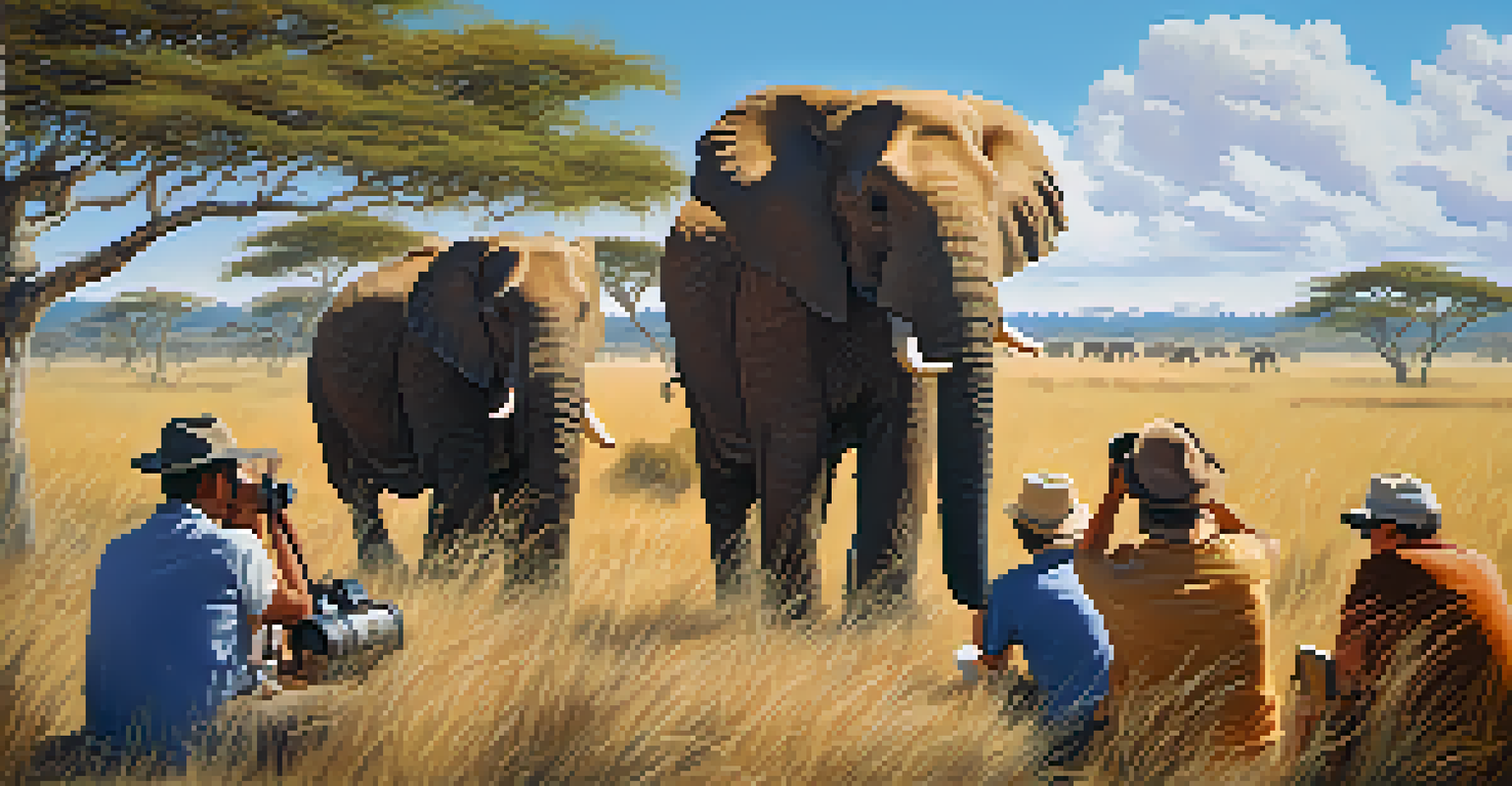Sustainable Wildlife Tours: A Key to Conservation

Understanding Sustainable Wildlife Tourism
Sustainable wildlife tourism is designed to provide travelers with unique experiences while ensuring the well-being of the environment and wildlife. This approach not only highlights the beauty of nature but also emphasizes responsible practices that protect habitats. By engaging in sustainable tours, travelers can enjoy wildlife safely and ethically, thereby fostering a deeper connection with nature.
The Earth does not belong to us: we belong to the Earth.
The concept revolves around minimizing negative impacts on ecosystems and local communities while enhancing biodiversity conservation. Tour operators often implement practices such as limiting group sizes, using eco-friendly transportation, and supporting local conservation initiatives. As a result, tourists leave with cherished memories and a sense of responsibility towards wildlife preservation.
In essence, sustainable wildlife tourism serves as a bridge connecting adventure lovers with conservation efforts, creating a win-win situation for both parties. It transforms the way we view travel, encouraging us to become mindful visitors who prioritize the planet's health. This mindful approach paves the way for a more sustainable future for wildlife and their habitats.
The Role of Wildlife Tours in Conservation Efforts
Wildlife tours play a crucial role in funding conservation projects and initiatives. A portion of the proceeds from these tours often goes directly into protecting natural habitats and supporting local wildlife. This financial support is vital, as many endangered species rely on these funds for survival and recovery efforts.

Moreover, these tours raise awareness about the challenges faced by wildlife, such as habitat loss and poaching. By educating tourists on these issues, operators empower them to become advocates for conservation. This ripple effect can lead to greater public support for policies and initiatives that protect wildlife.
Sustainable Tourism Benefits Wildlife
Engaging in sustainable wildlife tourism fosters conservation efforts while providing travelers with unique and responsible experiences.
The engagement between tourists and local communities also fosters a sense of stewardship. When local people see how wildlife tourism benefits them economically, they are more likely to participate in conservation efforts. This collaboration between tourists and communities creates a powerful alliance for protecting our planet's biodiversity.
Choosing Responsible Tour Operators
Selecting a responsible tour operator is essential for a sustainable wildlife experience. Look for companies that prioritize eco-friendly practices, such as minimizing waste and emphasizing conservation education. Reading reviews and doing some research can help ensure that your chosen operator aligns with your values.
In every walk with nature, one receives far more than he seeks.
Additionally, consider operators that engage with local communities and contribute to conservation projects. These companies often have a deeper understanding of the ecosystems they operate in, leading to more authentic and meaningful experiences for travelers. Supporting these businesses not only enriches your journey but also bolsters local economies.
Finally, don’t hesitate to ask questions. Inquire about the operator’s conservation policies and how they ensure the welfare of the wildlife you’ll be observing. A responsible operator will be transparent about their practices and eager to share their commitment to sustainability.
Wildlife Tours: A Learning Experience
One of the most enriching aspects of wildlife tours is the opportunity to learn from experts in the field. Guides often share their extensive knowledge about animal behaviors, ecosystems, and conservation challenges. This educational component transforms a simple trip into an enlightening adventure.
Understanding how ecosystems function can deepen your appreciation for the natural world. For instance, witnessing the intricate relationships between predator and prey can illustrate the delicate balance of nature. These experiences often leave a lasting impact, prompting travelers to consider their own roles in environmental stewardship.
Local Economies Thrive Through Tourism
Wildlife tourism generates essential income for local communities, promoting economic stability and encouraging conservation initiatives.
Moreover, learning about local cultures and traditions related to wildlife can enhance your travel experience. Many communities have unique practices that promote conservation, and engaging with them can provide invaluable insights. This cultural exchange enriches our understanding of the interconnectedness of all life on Earth.
The Economic Benefits of Wildlife Tourism
Wildlife tourism can significantly boost local economies, providing jobs and generating income for communities that may otherwise struggle. This economic incentive encourages local residents to engage in conservation efforts, as protecting wildlife directly impacts their livelihoods. In many cases, the income from tourism is a critical lifeline for these communities.
Furthermore, sustainable wildlife tourism drives investment in infrastructure, such as roads and facilities, which can benefit both visitors and locals. Improved infrastructure can lead to better access to education and healthcare, enhancing the quality of life for residents. This interconnectedness showcases how conservation can create wide-ranging benefits.
Ultimately, when communities thrive economically, they are more likely to prioritize the protection of their natural resources. This symbiotic relationship between wildlife tourism and local economies illustrates the powerful potential of sustainable practices in promoting both conservation and community well-being.
Challenges Facing Sustainable Wildlife Tours
Despite the numerous benefits, sustainable wildlife tourism does face challenges. Overcrowding in popular destinations can lead to habitat degradation and stress for animals. As more travelers flock to these areas, it becomes increasingly important to enforce limits and guidelines to protect wildlife.
Additionally, not all operators adhere to sustainable practices, leading to potential harm to ecosystems. Travelers must remain vigilant and discerning when choosing tours to ensure they are supporting ethical operators. This awareness can drive change, as demand for responsible tourism practices continues to grow.
Challenges Must Be Addressed
Overcrowding, unethical practices, and climate change pose significant challenges to sustainable wildlife tourism that require collective action.
Lastly, climate change poses a significant threat to wildlife and their habitats. As environments shift, many species struggle to adapt, and areas once teeming with wildlife may become less hospitable. Addressing these challenges requires collective action from tourists, operators, and conservationists to ensure that wildlife tourism remains a force for good.
Future of Sustainable Wildlife Tours
The future of sustainable wildlife tourism is promising, with growing awareness of environmental issues and a collective push for responsible practices. More travelers are seeking authentic experiences that prioritize conservation, reflecting a shift in consumer preferences. This trend is encouraging operators to adopt sustainable practices that benefit both wildlife and local communities.
Innovations in technology are also playing a role in shaping the future of wildlife tours. Virtual reality and online platforms can enhance the educational experience, allowing people to connect with wildlife from their homes. These technologies may serve as a bridge to inspire future travelers to engage with wildlife conservation in person.

Ultimately, the continued success of sustainable wildlife tours hinges on collaboration among tourists, operators, and conservation organizations. By working together, we can ensure that wildlife tourism remains a powerful tool for conservation and a means of fostering appreciation for our planet's biodiversity.